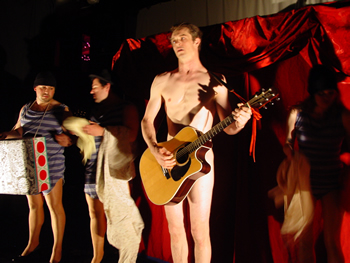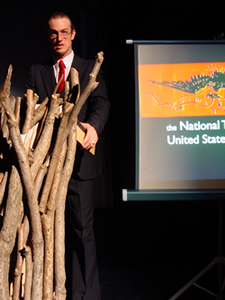
Exclamation Point
By Kevin Byrne
Chautauqua!
Created by the National Theatre of the United States of America
Written by James P. Stanley and Normandy Raven Sherwood
P.S. 122
(closed)
Chautauqua tried to create an ideal America
and Chautauqua! tried to create an ideal Chautauqua;
both were impossible projects.
The National Theatre of the United States
of America (NTUSA) has made failure an integral part of their
dramaturgy for the past several productions. Their 2006 Abacus
Black Strikes NOW!: The Rampant Justice of Abacus Black looked
at the compromises people make for the sake of security and their
2008 production of Molière's Don Juan highlighted the
changeable nature of even very pious people when faced with base
stimuli. Human fallibility has always been celebrated in their
shows, and for the company an equally human phenomenon is the
construction of idealized concepts that cannot really be reached.
Their past work has been inspired by various
performance styles from self-help seminars to game shows, but
with the Chautauqua form they seem to have found a perfect reflection
of their aesthetic mission. The Chautauqua tent show was a variety
entertainment that toured the rural United States throughout the
late nineteenth and early twentieth centuries, spreading knowledge
and nationalism. Its intent was to create stalwart, religious
Americans, and it carried its contradictions within itself. The
truths Chautauqua! holds to be self-evident are that
the United States is in reality a country obsessed with violence,
profit, and the pursuit of entertainment. NTUSA had only to amplify
some of the Chautauqua's internalized tensions to expose this
national enterprise. But more than just satirizing Chautauquas
and the audiences that made them popular, the show was an elegy
to a performance style it is no longer possible to present or
watch without a large helping of irony and a small dollop of melancholy.
Chautauqua provided both the form and content
of Chautauqua! It hewed to the tent shows' choppy vaudeville
format while at the same time describing and performing the decline
of their popularity. The performance included historical and philosophical
lectures, a reenactment of a famous duel, numerous songs, a handful
of dances, a puppet show/nature lecture, and random tidbits of
local knowledge. It began with the introduction of Master of Ceremonies Dick Pricey
(company member James P. Stanley), last seen introducing NTUSA's
Don Juan. Pricey was lecturer, curator, and commentator,
and his stuffy demeanor and stentorian tones recalled the traditional
Chautauqua personnel--his reactions to the more bizarre antics
of the other performers and his sometimes successful attempts
at keeping a lid on the proceedings continually reaffirmed the
distance between the contemporary audience's sensibilities and
those of their Chautauqua forbearers. Stanley brought an uncomfortable
earnestness to his role as professional scold, like a school dance
chaperone whose job is to police the punch bowl.
It began with the introduction of Master of Ceremonies Dick Pricey
(company member James P. Stanley), last seen introducing NTUSA's
Don Juan. Pricey was lecturer, curator, and commentator,
and his stuffy demeanor and stentorian tones recalled the traditional
Chautauqua personnel--his reactions to the more bizarre antics
of the other performers and his sometimes successful attempts
at keeping a lid on the proceedings continually reaffirmed the
distance between the contemporary audience's sensibilities and
those of their Chautauqua forbearers. Stanley brought an uncomfortable
earnestness to his role as professional scold, like a school dance
chaperone whose job is to police the punch bowl.
The bulk of the piece was devoted to Chautauqua-style
edutainment vignettes that barely hid a violent or exploitative
core underneath a genteel exterior. The humor of these scenes,
and they were very funny, was an interrelated mix of two comedic
tensions: the amateurishness of the presentation contrasted with
the dead seriousness of the presenters and the lofty aims of the
lectures concealing the compromising, messy humanity actually
on display.
An early lecture titled "Why I Like Maps"
was an overview of European cartography from the Renaissance to
the present that defended earlier maps full of speculation and
wonderment, preferring them over newer, scientifically calibrated
ones. One needn't be a hard-core Foucaultian to notice that in
decrying the mathematical maps, created to show trade routes,
the lecture was championing the individual discoverer over state-sponsored
and money-driven institutions.
The nature lecture "In the Mud" exposed
the eat-and-be-eaten processes in the chain of life from single-celled
organisms all the way up to marauding Cossacks (by way of larvae,
frog, bird, fox, bear, and vulture). This chain was dramatized
by colorful puppets and masks, and the lack of blood or dismemberment
did little to hide the Hobbesian bent of the thesis.
Another performance-within-a-performance
was a reenactment of the duel between Aaron Burr and Alexander
Hamilton that led to the latter's death. It was a piece of history,
of Americana, and of theatre, yet the drama and tension were undercut
by long digressions in which the actor playing Hamilton stepped
out of the scene to explain the niceties of dueling and the killing
power of eighteenth-century pistols. In all these examples, greed
was presented as triumphant and death as an unfair certainty,
even as the lecturer tried to convince us that the world was otherwise.
Dick Pricey delivered a eulogy to the Chautauqua
form as the performance drew to a close. Mass culture was certainly
the villain of the piece, or rather its fated tragic outcome.
The course of history drove the Chautauqua toward its own obsolescence
as its repressed salaciousness was displayed cheaper, faster,
and louder through its technologically distributed offspring.
To illustrate this, the shallow stage that
had housed the earlier lectures opened to reveal a large space
replete with black-leotarded dancers executing Merce Cunningham-esque
movements with mock solemnity--a humorous, if obvious, way of
sending up the pretensions of modern dance. The stage was then
flooded with dancers in multi-colored outfits while the music
and choreography changed to pure Flashdance. The saccharine
sweetness and forced jocularity of the scene went from goofy to
grating. I'm not sure if this was intentional, but the company
demonstrated its affinity for the old-fashioned Chautauquas by
choosing a truly obnoxious idiom for its representation of mass
culture.
 The
final tableau of Chautauqua! was a fantastic vision that
managed to be bizarre and also tender. The dancing morphed into
a leg show, and a very literal one at that: a surreal kick-line
of bare legs with upper torsos hidden beneath clever costume contraptions.
The flash-dancers lined up along the back wall, supporting the
letters of a huge blinking sign: CHAUTAUQUA! And then Dick Pricey,
defender of all things Chautauqua, began undressing with the same
awkward earnestness that characterized his other duties as emcee.
It was, he said, an act of love. We, the people, demanded this
of him. Stripped bare by his audience, Pricey confessed, "Now
may be the best time to tell you, we were paid to be here tonight."
He explained that an influential backer of the show forced the
company to add the more prurient spectacles and also forced them
to punctuate the show's title with an exclamation point. They
didn't want to do it, but, times being what they are…
The
final tableau of Chautauqua! was a fantastic vision that
managed to be bizarre and also tender. The dancing morphed into
a leg show, and a very literal one at that: a surreal kick-line
of bare legs with upper torsos hidden beneath clever costume contraptions.
The flash-dancers lined up along the back wall, supporting the
letters of a huge blinking sign: CHAUTAUQUA! And then Dick Pricey,
defender of all things Chautauqua, began undressing with the same
awkward earnestness that characterized his other duties as emcee.
It was, he said, an act of love. We, the people, demanded this
of him. Stripped bare by his audience, Pricey confessed, "Now
may be the best time to tell you, we were paid to be here tonight."
He explained that an influential backer of the show forced the
company to add the more prurient spectacles and also forced them
to punctuate the show's title with an exclamation point. They
didn't want to do it, but, times being what they are…
The play had little plot to speak of, other
than presenting a nostalgic vision of a bygone America that the
show itself kept undercutting. It was as sophisticated and pointed
as NTUSA's previous endeavors, and also more moving and sentimental.
This company has always found inspiration for their shows in various
entertainment genres. With Chautauqua! they found moments
of quiet sadness within the manic parody.
